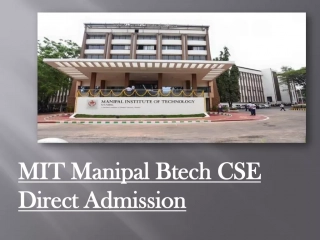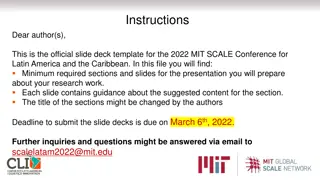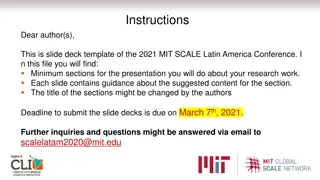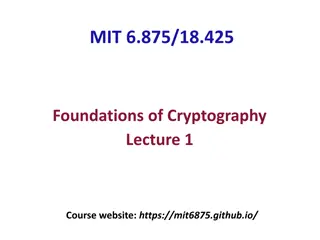MIT’s RISCY Expedition
Dive into the world of RISC-V processors with a focus on formal verification, operational models, memory consistency, and microarchitecture exploration. Learn about the Riscy Expedition's journey towards a fully verified and efficient RISC-V implementation.
Download Presentation

Please find below an Image/Link to download the presentation.
The content on the website is provided AS IS for your information and personal use only. It may not be sold, licensed, or shared on other websites without obtaining consent from the author.If you encounter any issues during the download, it is possible that the publisher has removed the file from their server.
You are allowed to download the files provided on this website for personal or commercial use, subject to the condition that they are used lawfully. All files are the property of their respective owners.
The content on the website is provided AS IS for your information and personal use only. It may not be sold, licensed, or shared on other websites without obtaining consent from the author.
E N D
Presentation Transcript
Computation Structures Group MIT s RISCY Expedition Andy Wright, Sizhuo Zhang, Thomas Bourgeat, Amol Bhave, Jamey Hicks, Arvind Computer Science & Artificial Intelligence Lab. Massachusetts Institute of Technology RISC V Workshop, Redwood Shores, CA January 6, 2015 1
Introduction We made an 64-bit RISC-V processor IMAFD extensions Machine, Supervisor, and User modes Boots RISC-V Linux with Sv39 Paged Virtual Memory Tandem verified with Spike Written in Bluespec System Verilog We are using this as a base for our Riscy Expedition 2
Riscy Expedition Formal specification of the ISA using an operational model Formally verified processor implementations Memory Consistency Models Should RISC V have a weak memory model? Which memory model? Accelerators Microarchitecture exploration VLSI implementations using standard ASIC flow push button synthesis Processors tuned for ASIC designs 3
Verified Design Our Philosophy: Get a working processor first, figure out why it is slow, and make it faster without breaking it There is no separation of Design and Verification There s just verified design Currently we are using Tandem Verification* In our expedition we are moving to Formal Verification * Technology developed by Bluespec Inc 4
Tandem verification Synchronized HTIF HTIF Spike RiscyFpga Jmp a; Jmp a; ??????(?) = ??????(?) pc pc S contains : The pc at step n. The instruction executed at step n The operands and the concerned registers The packets exchanged with HTIF, if exists The memory operations wanted to be performed, if exists Very useful but for highly-parameterized designs it provides only a weak sense of correctness 5
Formal Verification and Specification Formal Verification is constructing a proof that a processor matches a formal specification But we need a formal specification for RISC-V In the ISA there are lots of (odd) cases that need to be specified for a formal verification Are referenced bits in page table entries set for speculatively accessed pages? A single instruction can result in up to 13 effective memory accesses. How exactly do they interact with each other? How does they influence the memory model? 6
Memory Consistency Model Strong consistency models (e.g. SC, TSO) Easy to understand, but restricts optimizations Weak consistency models Permit HW optimizations, but difficult to understand Release Consistency (RC) Defined with operation performed with respect to certain processor Power/ARM Definition in official ISA is not clear General description: no ordering should be assumed Special cases where ordering is enforced Dependent loads cannot be reordered 7
We want Simple operational definitions Legal behaviors must be observable on a simple abstract machine consisting of cores and a shared monolithic memory Cores execute one instruction at a time in program order May have local buffers, like the store buffer used to define TSO; useful in modeling implicit reordering of memory instructions The effect of Fence instructions is to flush local buffers Multi-ported monolithic memory which processes one read or write immediately 8
WMM: A new weak consistency model WMM is defined using a store buffer and an invalidation buffer per core Permits all load-store reorderings except stores overtaking loads Allows almost all microarchitectural optimizations out-of-order execution memory dependency speculation load-value speculation Provides an easy to understand operational model between cores 9
Flavored Memory Accesses Inst. Fetch Exec. Mem. TLB TLB Input/Output (IO) Instruction Fetch (I) Data Access (D) Virtual Address Translation (VAT) This looks like 4 separate cores accessing the same memory 10
Flavored Memory Synchronization SFENCE.VM D.ST < SFENCE.VM < VAT.LD VAT.LD must see result of D.ST With this specification, some SFENCE.VMs are missing from the Linux kernel No instruction for the other direction (yet) VAT.ST < ? < D.LD So does D.LD always need to see the results of all previous VAT.STs immediately? We are looking at these flavored accesses closely and incorporating them into the memory model 11
Further Work Accelerators Convolutional Neural Network accelerator in BlueDBM Microarchitecture Out-of-order execution multicore processor ASIC Implementation Processor building blocks tuned for ASIC performance 12
Questions? Contact information: Andy Wright acwright@mit.edu csg.csail.mit.edu/riscy-e 13

 undefined
undefined
























